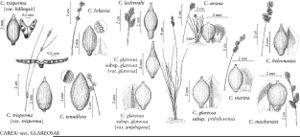Carex glareosa subsp. glareosa
Culms often curved, weak, 10–25 cm. Leaves ± gray-green, often channeled, rarely flat, 1–2 mm wide. Inflorescences 7–25 × 5–12 mm. Pistillate scales 2–3 mm, rarely enveloping perigynia. Perigynia lightly or obscurely several-veined on faces, 1.5–3.5 × 1–1.5 mm.
Phenology: Fruiting Jun–Aug.
Habitat: Salt marshes, gravelly seashores
Elevation: 0–100 m
Distribution

Greenland, B.C., Man., N.B., Nfld. and Labr., N.W.T., Nunavut, Ont., P.E.I., Que., Yukon, Alaska, Europe
Discussion
G. Halliday and A. O. Chater (1969) recognized two well-defined varieties in the subspecies: var. glareosa and var. amphigena. Variety amphigena, which is the overwhelmingly dominating type in North America, has pale brown to whitish, broadly elliptic-obovate perigynia (1.5–2.5 × 1.3–1.5 mm) contracting abruptly into a minute beak. Variety glareosa often has lanceolate, light brown to whitish, and sometimes distinctly ribbed perigynia more than 2.6 times as long as wide and 2.5–3.5 × 1–1.5 mm in size. According to G. Halliday and A. O. Chater (1969), it is an amphi-Atlantic plant. It occurs in Greenland and a few places in eastern Canada, and it is relatively common in Fennoscandia (Finland and Scandinavia) and northwestern Russia. In many places it grades to the var. amphigena.
Selected References
None.
Lower Taxa
"shortened" is not a number.
